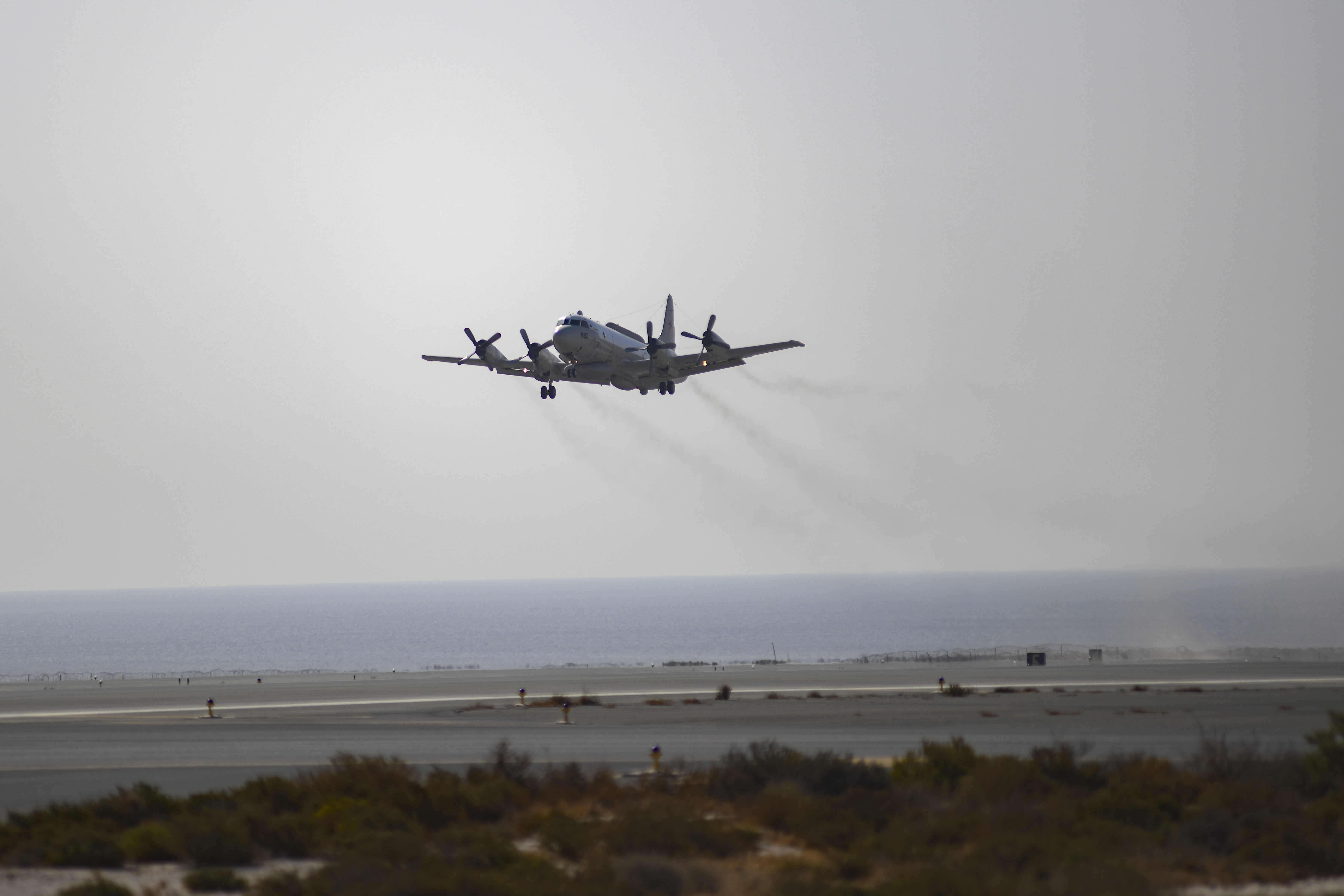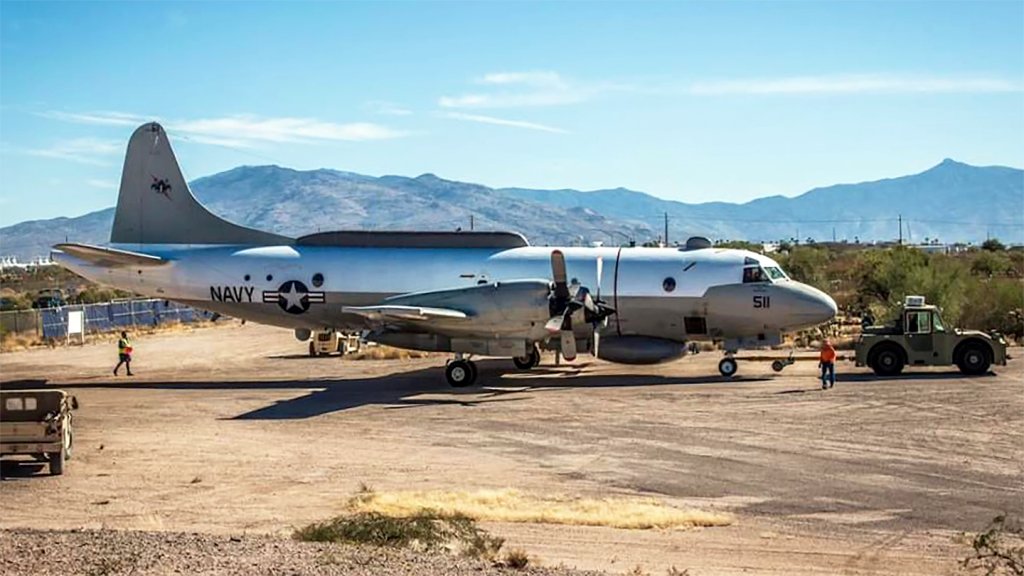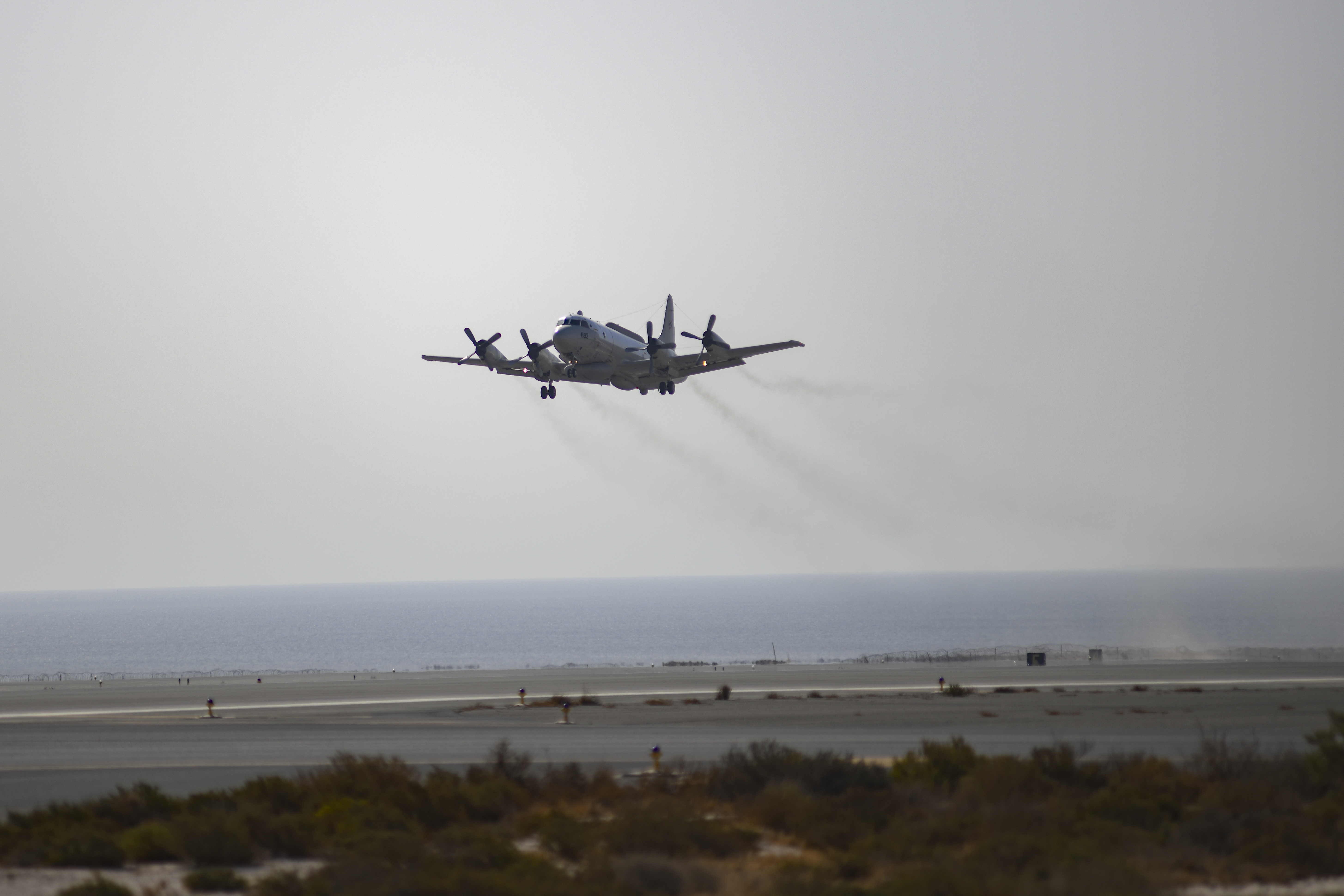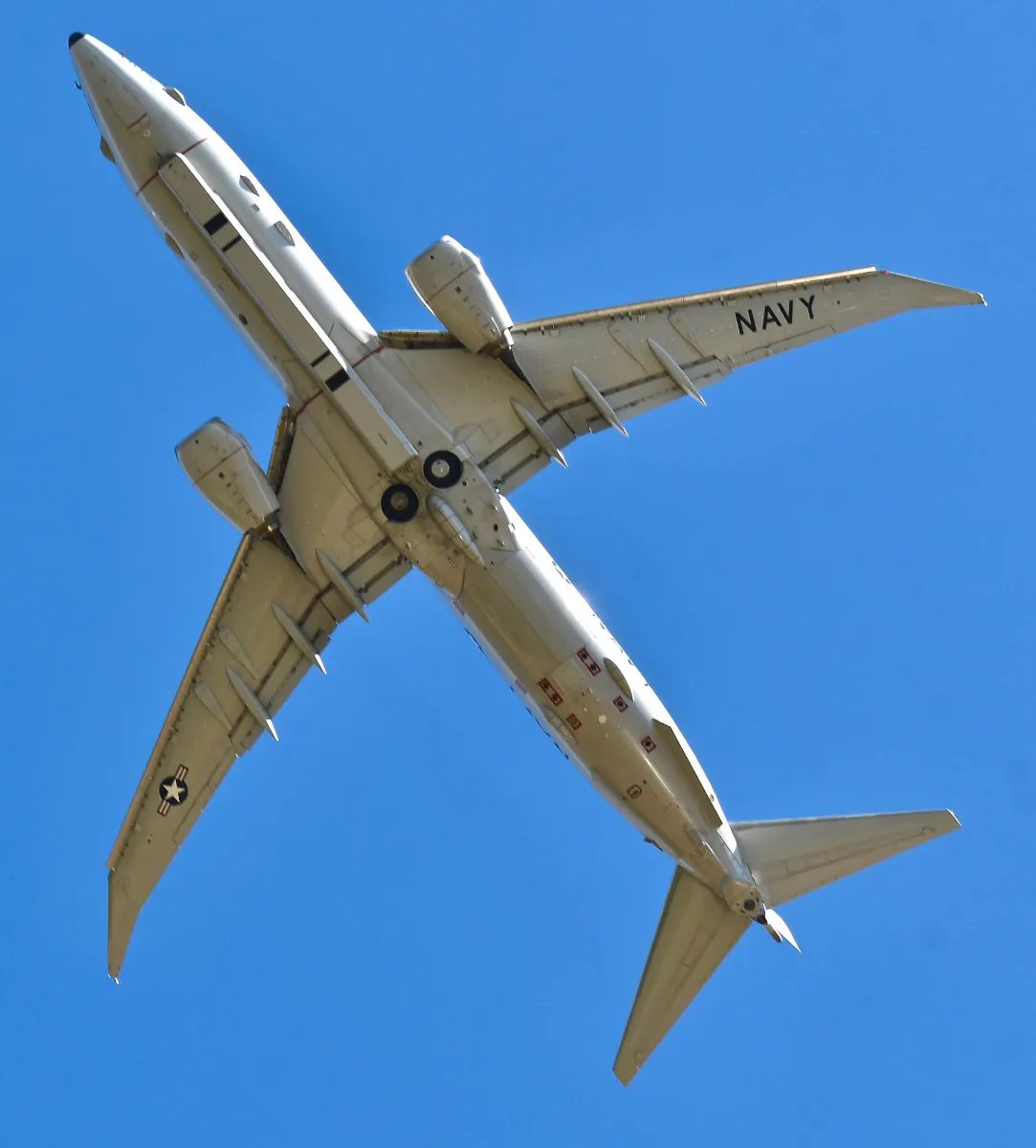Another long-serving U.S. military aircraft has completed its final operational deployment, with the return of the U.S. Navy’s EP-3E Aries II surveillance platform from the 5th Fleet area of operations. The countdown to the spy plane’s final retirement is now on, which will see its vital intelligence, surveillance, and reconnaissance (ISR) mission handed over to the P-8A Poseidon maritime patrol plane, the MQ-4C Triton high-altitude, long-endurance drone, and other assets, including ones in space.
The last EP-3E deployed on operations was Bureau Number, or BuNo 159893, which completed its final flight in the U.S. 5th Fleet area of operations on October 29. The aircraft then made a homecoming to its base at Naval Air Station Whidbey Island, Washington, according to the Facebook account of Fleet Air Reconnaissance Squadron 1 (VQ-1), the “World Watchers,” which posted photos of the event yesterday.

The U.S. 5th Fleet area of operations covers approximately 2.5 million square miles of water and includes the Arabian Gulf, Red Sea, Gulf of Oman, as well as parts of the Indian Ocean. The area includes three highly strategic choke points at the Strait of Hormuz, the Suez Canal, and the Strait of Bab el-Mandeb at the southern tip of Yemen.
The tense security situation in the region at the moment saw the EP-3E’s final operational deployment extended.

Originally, the U.S. Navy had scheduled VQ-1 to cease operations by September 30, 2024, ahead of the formal deactivation of the unit on March 31, 2025.
According to the VQ-1 Facebook account, the squadron was first ordered to delay the cessation of operations until October 8, 2024, after which it was required to continue its missions in the region until an undetermined date.

Another VQ-1 EP-3E that had been deployed also recently returned to Whidbey Island, with photos of that aircraft’s homecoming posted by the unit on November 4. BuNo 161410 had been operating from Souda Bay, on the Greek island of Crete, under U.S. Central Command.
For some time now, the Navy has been sending EP-3Es into retirement, delivering them to the 309th Aerospace Maintenance and Regeneration Group (AMARG) at Davis-Monthan Air Force Base, Arizona, for storage.
As we reported last month, the most famous EP-3E of all — BuNo 156511, which was involved in a collision with a Chinese J-8 interceptor over Hainan Island in 2001 — has been moved from the AMARG boneyard to go on public display in the future at the Pima Air & Space Museum in Tucson, Arizona.

Meanwhile, the end of the EP-3’s operational commitment after nearly six decades of service was commemorated by the Navy. A press release from the service included recollections from EP-3E crew members, providing a rare glimpse into a highly secretive community, and one with a very sensitive mission.
“It’s amazing to think of the number of folks who have been part of the EP-3 heritage over the last 55 years,” said Lt. Cmdr. Justin “Gump” Roberts, the VQ-1 detachment officer-in-charge. “Success in this platform has solely been because of our hard-working maintenance team while on deck and our aircrew’s superior ISR while on station. It’s an honor to be part of a legacy that’s bigger than the sum of its parts.”
The aircraft commander at VQ-1, Lt. Bradford “Chad” Holcombe, added that he was “tremendously grateful” to be part of the EP-3E’s history.
“From my first day at VQ-1, it’s been obvious to see the pride each member has in the platform, the mission, and most importantly the effort it takes to execute wherever and whenever we’re asked,” he said. “Flying the last mission flight is a privilege.”

Finally, words were offered by Capt. Dennis “Rudy” Jensen, Commodore of Task Force 57:
“My father was a P-3 pilot during the Cold War, and I’ve flown the variants of the same aircraft since 2002. Few other airplanes are as ‘time-tested and mother approved’ as the P-3,” Jensen said. “Its longevity and ability to operate from remote locations in austere environments for over half a century is a testament to those who designed, built, maintained, and operated it. Much like the ever-changing platforms onboard the flight deck of an aircraft carrier, the mission systems inside the EP-3E have evolved over time. The ability to evolve has enabled the EP-3E to remain viable and effective through today.”
During its time in operational service, the EP-3E played a fairly covert role as a central intelligence-gathering asset within the Navy’s Maritime Patrol and Reconnaissance Force (MPRF).
Derived from the P-3 Orion maritime patrol aircraft, the EP-3E was optimized for operations in the maritime/littoral domain. It was packed with equipment to gather real-time tactical signals intelligence (SIGINT), including intercepting communications and locating and classifying emitters, especially those related to hostile air defense systems.

A typical EP-3E comprised six flight crew and a reconnaissance crew of 18, pulled from the Navy, Marines, and Air Force.
Data could be processed and analyzed onboard by the crew, then fused together with other critical information. The resulting ‘product,’ including full-motion video intelligence, could be provided in near real-time to fleet and theater commanders.
Overall, the EP-3E was able to provide commanders with specific indications and warnings, as well as build a better picture of the battlespace for situational awareness. Intelligence it gathered on air defense systems would be potentially vital for the suppression and destruction of enemy air defenses, while other information would be used for anti-air warfare and anti-submarine warfare applications.
Successive upgrades ensured that the EP-3E remained a valuable asset and also added new capabilities. While it was primarily a SIGINT platform in the early years, it later became a ‘multi-intelligence reconnaissance aircraft,’ with new equipment that could hoover up a variety of electronic emissions including at long standoff range.

The EP-3E’s mission saw it operate in various high-threat areas throughout its career. As well as around the coasts of China — which led to the Hainan Island Incident — regular areas of interest included the Mediterranean Sea, Middle East, and Caribbean. In the process, intercepts by hostile or potentially hostile fighters were commonplace.
The video below shows an encounter between an EP-3E and a Russian Su-27 Flanker fighter jet over the Black Sea, in 2018. On that occasion, the Navy says the jet came within five feet of the surveillance aircraft, causing a mission abort, and return to base.

Replacing the EP-3E with the MQ-4C has been a gradual process. Tritons have been operating from forward deployment bases in Guam in the Pacific and Sigonella in the Mediterranean, for some time. Most recently, a third Triton deployment base was established in the U.S. 5th Fleet area of operations, on October 1, allowing the EP-3E to stand down from its duties there.

Flying at a higher altitude and offering a longer endurance than the EP-3E, the MQ-4C offers some significant advantages. While a multi-mission platform, it’s the Triton’s so-called Multi-Intelligence (Multi-Int) configuration with additional electronic and signals intelligence capabilities that will take over from the EP-3E. Since it’s uncrewed, there is also no risk to the crew, something that EP-3E operators were exposed to on a fairly regular basis.
Despite this, in 2022 the Navy decided to dramatically reduce its total planned purchases of MQ-4Cs from 70 to 27. This came after increased questions about the drone’s survivability after one of the interim Broad Area Maritime Surveillance Demonstrator (BAMS-D) aircraft was shot down by Iran in 2019.
Some of the EP-3E’s missions will also be taken over by the P-8A Poseidon maritime patrol aircraft. The baseline Poseidon has a signals intelligence capability, allowing it to detect, geolocate, and classify emissions, including from radars and other air defense nodes, which is also now set to be upgraded. Some P-8s are configured to carry other intelligence-gathering payloads, such as the AN/APS-154 Advanced Airborne Sensor, as well. Boeing has internally funded the development of a modular multi-mission gondola-like pod for Poseidon, which is set to offer an additional way to rapidly integrate sensors and other capabilities.

“The transition from the EP-3E to the P-8A Poseidon and MQ-4C Triton platforms has been carefully planned to avoid capability gaps,” the Navy said. “These platforms offer enhanced intelligence, surveillance, and reconnaissance capabilities, with greater range, endurance, and the ability to operate in more complex environments.”
The Navy will also be able to leverage other emerging U.S. military ISR assets, including new spaced-based surveillance capabilities.
While the EP-3E’s time is now nearly up, there remain a handful of other Orion variants still in U.S. Navy service. These include P-3C, NP-3C, and NP-3D aircraft flown by Air Test and Evaluation Squadron 30 (VX-30) at Naval Air Station Point Mugu, California, and by Scientific Development Squadron One (VXS-1) at NAS Patuxent River, Maryland. Many of these are also in the process of being replaced.
While many secrets of the EP-3’s exploits are still to be revealed, there’s little doubt that this platform made an enormous contribution to gathering intelligence from hotspots around the globe during its long and eventful period of service.
Contact the author: thomas@thewarzone.com
